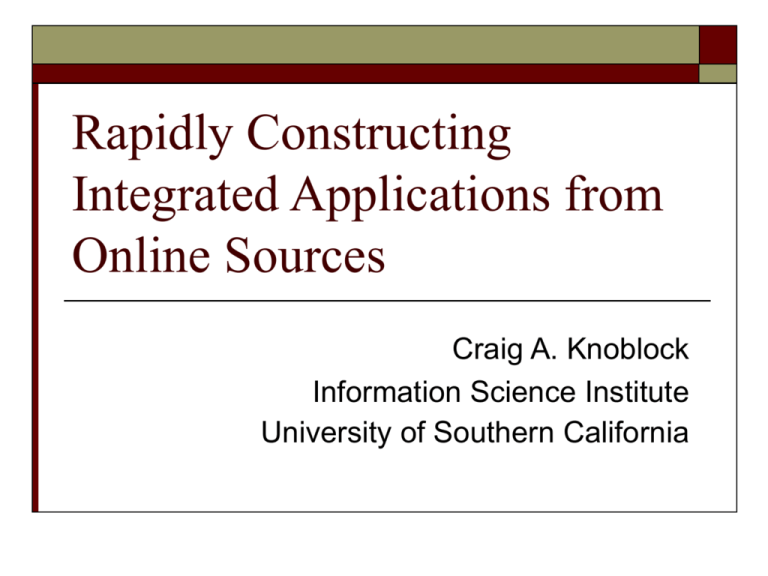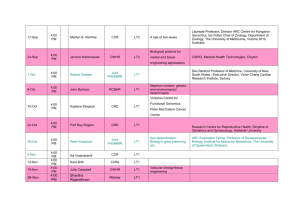06-04-18 Wayne State..
advertisement

Rapidly Constructing
Integrated Applications from
Online Sources
Craig A. Knoblock
Information Science Institute
University of Southern California
Motivating Example
BiddingForTravel.com
Priceline
?
Map
Orbitz
Outline
Extracting data from unstructured and
ungrammatical sources
Automatically discovering models of sources
Dynamically building integration plans
Efficiently executing the integration plans
Outline
Extracting data from unstructured and
ungrammatical sources
Automatically discovering models of sources
Dynamically building integration plans
Efficiently executing the integration plans
Ungrammatical & Unstructured Text
Ungrammatical & Unstructured Text
For simplicity “posts”
<hotelArea>univ. ctr.</hotelArea>
Goal:
<price>$25</price><hotelName>holiday inn sel.</hotelName>
Wrapper based IE does not apply (e.g. Stalker, RoadRunner)
NLP based IE does not apply (e.g. Rapier)
Reference Sets
IE infused with outside knowledge
“Reference Sets”
Collections of known entities and the associated
attributes
Online (offline) set of docs
CIA World Fact Book
Online (offline) database
Comics Price Guide, Edmunds, etc.
Algorithm Overview – Use of Ref Sets
Post:
$25 winning bid at
holiday inn sel. univ. ctr.
Reference Set:
Holiday Inn Select
Hyatt Regency
Ref_hotelName
University Center
Downtown
Ref_hotelArea
Record Linkage
$25 winning bid at
holiday inn sel. univ. ctr.
Holiday Inn Select University Center
“$25”, “winning”, “bid”, …
Extraction
$25 winning bid … <price> $25 </price> <hotelName> holiday inn
sel.</hotelName> <hotelArea> univ. ctr. </hotelArea>
<Ref_hotelName> Holiday Inn Select </Ref_hotelName>
<Ref_hotelArea> University Center </Ref_hotelArea>
Our Record Linkage Problem
Posts not yet decomposed attributes.
Extra tokens that match nothing in Ref Set.
Post:
“$25 winning bid at holiday inn sel. univ. ctr.”
Reference Set:
hotel name
hotel area
Holiday Inn
Greentree
Holiday Inn Select
University Center
Hyatt Regency
Downtown
hotel name
hotel area
Our Record Linkage Solution
P = “$25 winning bid at holiday inn sel. univ. ctr.”
Record Level Similarity + Field Level Similarities
VRL = < RL_scores(P, “Hyatt Regency Downtown”),
RL_scores(P, “Hyatt Regency”),
RL_scores(P, “Downtown”)>
Binary Rescoring
Best matching member of the reference set for the post
Extraction Algorithm
Post:
$25
winning bid at holiday inn sel. univ. ctr.
Generate VIE
Multiclass SVM
VIE = <common_scores(token),
IE_scores(token, attr1),
IE_scores(token, attr2),
…>
$25 winning bid at holiday inn sel. univ. ctr.
price
$25
hotel name
holiday inn sel.
Clean Whole Attribute
hotel area
univ. ctr.
Experimental Data Sets
Hotels
Posts
1125 posts from www.biddingfortravel.com
Pittsburgh, Sacramento, San Diego
Star rating, hotel area, hotel name, price, date booked
Reference Set
132 records
Special posts on BFT site.
Per area – list any hotels ever bid on in that area
Star rating, hotel area, hotel name
Comparison to Existing Systems
Record Linkage
WHIRL
RL allows non-decomposed attributes
Information Extraction
Simple Tagger (CRF)
State-of-the-art IE
Amilcare
NLP based IE
Record linkage results
Prec.
Recall
F-Measure
Hotel
Phoebus
93.60
91.79
92.68
WHIRL
83.52
83.61
83.13
10 trials – 30% train, 70% test
Token level Extraction results:
Hotel domain
Prec.
Area
Date
Name
Price
Star
Recall
F-Measure
Phoebus
89.25
87.50
88.28
Simple Tagger
92.28
81.24
86.39
Amilcare
74.2
78.16
76.04
Phoebus
87.45
90.62
88.99
Simple Tagger
70.23
81.58
75.47
Amilcare
93.27
81.74
86.94
Phoebus
94.23
91.85
93.02
Simple Tagger
93.28
93.82
93.54
Amilcare
83.61
90.49
86.90
Phoebus
98.68
92.58
95.53
Simple Tagger
75.93
85.93
80.61
Amilcare
89.66
82.68
85.86
Phoebus
97.94
96.61
97.84
Simple Tagger
97.16
97.52
97.34
Amilcare
96.50
92.26
94.27
Freq
809.7
751.9
1873.9
850.1
766.4
Not Significant
Outline
Extracting data from unstructured and
ungrammatical sources
Automatically discovering models of sources
Dynamically building integration plans
Efficiently executing the integration plans
Discovering Models of Sources
Required for Integration
Provide uniform access to heterogeneous sources
Source definitions are used to reformulate queries
New service, no source model, no integration!
Can we discover models automatically?
United
Mediator
Query
SELECT MIN(price)
FROM flight
WHERE depart=“MXP”
AND arrive=“PIT”
Source
Definitions:
- United
- Lufthansa
- Qantas
Web
Services
Lufthansa
Reformulated Query
Qantas
calcPrice(“MXP”,“PIT”,”economy”)
Alitalia
new
service
Inducing Source Definitions:
A Simple Example
Step 1: use metadata to classify input types
Step 2: invoke service and classify output types
known
source
Mediator
LatestRates($country1,$country2,rate):exchange(country1,country2,rate)
Semantic Types:
currency {USD, EUR, AUD}
rate {1936.2, 1.3058, 0.53177}
currency
Predicates:
exchange(currency,currency,rate)
new
source
rate
RateFinder($fromCountry,$toCountry,val):- ?
{<EUR,USD,1.30799>,<USD,EUR,0.764526>,…}
Inducing Source Definitions:
A Simple Example
Step 3: generate plausible source definitions
Step 4: reformulate in terms of other sources
Step 5: invoke service and compare output
match
currency
rate
Input
RateFinder
Def_1
<EUR,USD>
1.30799
1.30772
<USD,EUR>
0.764526
RateFinder($fromCountry,$toCountry,val):0.764692
1.30772
<EUR,AUD>
1.68665
Mediator
1.68979
Def_2
new
source
0.764692
?
0.591789
def_1($from, $to, val) :- exchange(from,to,val)
def_2($from, $to, val) :- exchange(to,from,val)
def_1($from, $to, val) :- LatestRates(from,to,val)
Predicates:
exchange(currency,currency,rate) def_2($from, $to, val) :- LatestRates(to,from,val)
The Framework
Intuition: Services often have similar semantics, so we
should be able to use what we know to induce that
which we don’t
Two phase algorithm
For each operation provided by the new service:
1.
Classify its input/output data types
Classify inputs based on metadata similarity
Invoke operation & classify outputs based on data
Induce a source definition
2.
Generate candidates via Inductive Logic Programming
Test individual candidates by reformulating them
Use Case: Zip Code Data
Single real zip-code service with multiple operations
The first operation is defined as:
getDistanceBetweenZipCodes($zip1, $zip2, distance) :centroid(zip1, lat1, long1),
centroid(zip2, lat2, long2),
distanceInMiles(lat1, long1, lat2, long2, distance).
Goal is to induce definition for a second operation:
getZipCodesWithin($zip1, $distance1, zip2, distance2) :centroid(zip1, lat1, long1),
centroid(zip2, lat2, long2),
distanceInMiles(lat1, long1, lat2, long2, distance2),
(distance2 ≤ distance1),
(distance1 ≤ 300).
Same service so no need to classify inputs/outputs or match
constants!
Generating definitions: ILP
Want to induce source definition for:
getZipCodesWithin($zip1, $distance1, zip2, distance2)
Plausible
Source Definition
Predicates available
for generating
definitions:INVALID
1
cen(z1,lt1,lg1), cen(z2,lt2,lg2),
dIM(lt1,lg1,lt2,lg2,d1),
{centroid, distanceInMiles,
≤,=} (d2 = d1)
2
cen(z1,lt1,lg1), cen(z2,lt2,lg2), dIM(lt1,lg1,lt2,lg2,d1), (d2 ≤ d1)
3
cen(z1,lt1,lg1), cen(z2,lt2,lg2), dIM(lt1,lg1,lt2,lg2,d2), (d2 ≤ d1)
Use known definition as starting point for local
cen(z1,lt1,lg1), cen(z2,lt2,lg2), dIM(lt1,lg1,lt2,lg2,d2), (d1 ≤ d2)
4
d2 unbound!
New type signature contains that of known source
#d is a
constant
search:
6
getDistanceBetweenZipCodes($zip1, $zip2, distance)
:UNCHECKABLE
cen(z1,lt1,lg1),
cen(z2,lt2,lg2),
dIM(lt1,lg1,lt2,lg2,d2),
(d1 ≤ #d)
centroid(zip1,
lat1,
long1),
lt1 inaccessible!
cen(z1,lt1,lg1),
cen(z2,lt2,lg2),
dIM(lt1,lg1,lt2,lg2,d2),
(lt1 ≤ d1)
centroid(zip2,
lat2,
long2),
contained in
distanceInMiles(lat1,
long1, lat2, long2, distance).
…
defs 2 & 4
n
cen(z1,lt1,lg1), cen(z2,lt2,lg2), dIM(lt1,lg1,lt2,lg2,d2), (d2 ≤ d1), (d1 ≤ #d)
5
Preliminary Results
Settings:
Number of zip code constants initially available: 6
Number of samples performed per trial: 20
Number of candidate definitions in search space: 5
Results:
Converged on “almost correct’’ definition!!!
getZipCodesWithin($zip1, $distance1, zip2, distance2) :centroid(zip1, lat1, long1),
centroid(zip2, lat2, long2),
distanceInMiles(lat1, long1, lat2, long2, distance2),
(distance2 ≤ distance1),
(distance1 ≤ 243).
Number of iterations to convergence: 12
Related Work
Classifying Web Services
(Hess & Kushmerick 2003), (Johnston & Kushmerick 2004)
Classify input/output/services using metadata/data
We learn semantic relationships between inputs & outputs
Category Translation
(Perkowitz & Etzioni 1995)
Learn functions describing operations available on internet
We concentrate on a relational modeling of services
CLIO
(Yan et. al. 2001)
Helps users define complex mappings between schemas
They do not automate the process of discovering mappings
iMAP
(Dhamanka et. al. 2004)
Automates discovery of certain complex mappings
Our approach is more general (ILP) & tailored to web sources
We must deal with problem of generating valid input tuples
Outline
Extracting data from unstructured and
ungrammatical sources
Automatically discovering models of sources
Dynamically building integration plans
Efficiently executing the integration plans
Dynamically Building
Integration Plans
Traditional Data Integration
Techniques
(1). SwissProtein: P36246
(2). GeneBank: AAS60665.1
………
Find information about all
proteins that participate in
Transcription process
Mediator
Dynamically Building
Integration Plans (Cont’d)
Problem Solved Here
Create a web service that
accepts a name of a biological
process, <bname>, and
returns information about
proteins that participate in it
New web service
Mediator
Problem Statement (Cont’d)
Assumption
Information-producing web service
operations
Applicability
Biological data web services
Geospatial services (WMS, WFS)
Other applications that do not focus on
transactions
Query-based Web Service
Composition
Query-based approach
View web service operations as source relations with
binding restrictions
Create domain ontology
Describe source relations in terms of domain relations
Can be inferred from WSDL
Combined Global-as-View / Local-as-View approach
Use data integration system to answer user queries
Template-based Web Service
Composition
Our goal is to compose new web services
We need to answer template queries, not specific
queries
Template-based Query Approach
Generate plans to take into account general parameter
values,
Easy to generate universal plan
i.e. Universal Plan [Schoppers, et. al.]
Plans that answer template query as oppose to specific
query
But, plans can be very inefficient
Need to generate optimized “universal integration plans”
Example Scenario
Sources
HSProtein($id, name, location, function, seq, pubmedid)
MMProtein($id, name, location, function, seq, pubmedid)
Protein
TranducerProtein($id, name, location, taxonid, seq, pubmedid)
MembraneProtein($id, name, location, taxonid, seq, pubmedid)
DipProtein($id, name, location, taxonid, function)
Protein-Protein
Interactions
MMProteinInteractions($fromid, toid, source, verified)
HSProteinInteractions($fromid, toid, source, verified)
Example Rules and Query
ProteinProteinInteractions(fromid, toid, taxonid, source, verified):HSProteinInteractions(fromid, toid, source, verified),(taxonid=9606)
ProteinProteinInteractions(fromid, toid, taxonid, source, verified):MMProteinInteractions(fromid, toid, source, verified), (taxonid=10090)
ProteinProteinInteractions(fromid, toid, taxonid, source, verified):ProteinProteinInteractions(fromid, itoid, taxonid, source, verified),
ProteinProteinInteractions(itoid, toid, taxonid, source, verified)
Q(fromid, toid, taxonid, source, verified):fromid = !fromid,
taxonid = !taxonid,
ProteinProteinInteractions(fromid, toid, taxonid, source, verified)
Unoptimized Plan
Optimized Plan
Exploit constraints in source description to
filter queries to sources
Example Scenario
Q1(fromid, fromname, fromseq, frompubid, toid, toname, toseq, topubid):fromid = !fromproteinid,
Protein(fromid, fromname, loc1, f1, fromseq, frompubid, taxonid1),
ProteinProteinInteractions(fromid, toid, taxonid, source, verified),
Protein(toid, toname, loc2, f2, toseq, topubid, taxonid2)
Output
Input
Fromproteinid, fromseq,
Toproteinid, toseq
Fromproteinid
ComposedPlan
Fromproteinid, fromseq
Join
Protein
Protein-Protein
Interactions
Fromproteinid,
Toproteinid
Fromproteinid,
Toproteinid, toseq
Protein
Example Integration Plan
Adding Sensing Operations for
Tuple-level Filtering
Compute original plan for a template query
For each constraint on the sources
Introduce constraint into the query
Rerun inverse rules algorithm
Compare cost of new plan to original plan
Save plan with lowest cost
Optimized Universal Integration Plan
Outline
Extracting data from unstructured and
ungrammatical sources
Automatically discovering models of sources
Dynamically building integration plans
Efficiently executing the integration plans
Dataflow-style, Streaming
Execution
Map datalog plans into streaming, dataflow execution
system (e.g., network query engine)
We use the Theseus execution system since it
supports recursion
Key challenges
Mapping non-recursive plans
Mapping recursive plans
Data processing
Loop detection
Query results update
Termination check
Recursive callback
Example Translation
ProteinProteinInteractions(fromid, toid, taxonid, source, verified):HSProteinInteractions(fromid, toid, source, verified),(taxonid=9606)
ProteinProteinInteractions(fromid, toid, taxonid, source, verified):MMProteinInteractions(fromid, toid, source, verified), (taxonid=10090)
ProteinProteinInteractions(fromid, toid, taxonid, source, verified):ProteinProteinInteractions(fromid, itoid, taxonid, source, verified),
ProteinProteinInteractions(itoid, toid, taxonid, source, verified)
Q(fromid, toid, taxonid, source, verified):ProteinProteinInteractions(fromid, toid, taxonid, source, verified),
(fromid = !fromproteinid),
(taxonid = !taxonid)
Example Theseus Plan
Bio-informatics Domain Results
Experiments in Bio-informatics domain where we have 60 real
web services provided by NCI
We varied number of domain relations in a query from 1-30 and
report composition time with execution time
Time in Miliseconds
16000
14000
12000
10000
Execution Time
8000
Composition Time
6000
4000
2000
0
1
2
3
4
5
6
# of Relations in Query
7
8
Tuple-level Filtering
Tuple-level filtering can improve the execution time of the
generated integration plan by up to 53.8%
Improvement due to Theseus
Theseus can improve the execution time of the generated web
service with complex plans by up to 33.6%
Discussion
Huge number of sources available
Need tools and systems that support the dynamic
integration of these sources
In this talk, I described techniques for:
Extracting data from unstructured and ungrammatical
sources
Discovering models of online sources required for
integration
Dynamic and efficient integration of web sources
Efficient execution of integration plans
Much work still left to be done…
More information…
http://www.isi.edu/~knoblock
Matthew Michelson and Craig A. Knoblock.
Semantic Annotation of Unstructured and Ungrammatical Text
In Proceedings of the 19th International Joint Conference on Artificial
Intelligence (IJCAI), Edinburgh, Scotland, 2005
Mark James Carman and Craig A. Knoblock.
Inducing source descriptions for automated web service composition,
In Proceedings of the AAAI 2005 Workshop on Exploring Planning and
Scheduling for Web Services, Grid, and Autonomic Computing, 2005.
Snehal Thakkar, Jose Luis Ambite, and Craig A. Knoblock.
Composing, optimizing, and executing plans for bioinformatics web
services,
VLDB Journal, Special Issue on Data Management, Analysis and Mining
for Life Sciences, 14(3):330--353, Sep 2005.
